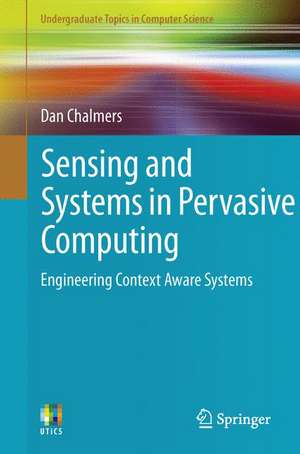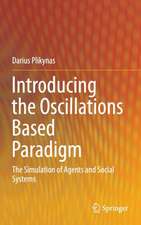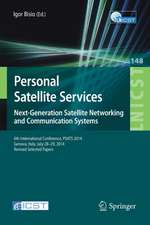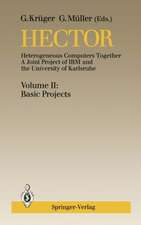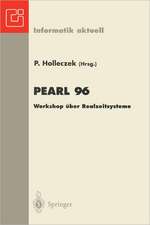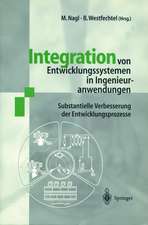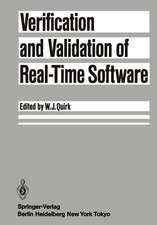Sensing and Systems in Pervasive Computing: Engineering Context Aware Systems: Undergraduate Topics in Computer Science
Autor Dan Chalmersen Limba Engleză Paperback – 25 iul 2011
Low power and a wide range of different hardware;
Personal and local area wireless networking and networks of smart sensors;
Location sensing and handling located data;
Adaptation to the environment, or context, in various ways;
Data processing which considers state, events, time-varying signals and noise;
Systems design for scalability and handling variation, beyond Internet scales.
Sensing and Systems in Pervasive Computing brings together these issues in a practical form for the undergraduate or postgraduate -- describing the core ideas and providing programming exercises which explore these issues. Many of the programming exercises are described in terms of the Phidgets sensor interfacing kits, but are easily adapted to other hardware. The references refer to recent research, but focuses on more established principles rather than the latest technology in the selection of ideas. Each chapter is accompanied by suggested readings, guiding the student into the large body of scientific papers in this area.
Depending on the emphasis given, Sensing and Systems in Pervasive Computing, can be used to support an introduction tothe use of sensors; an advanced course on pervasive computing and research techniques; or to give an introduction to the area for research students. The approach taken includes mathematics where necessary without being overly technical, and includes guidance on problem solving and experimental techniques which some computing undergraduates seem to miss.
Din seria Undergraduate Topics in Computer Science
- 20%
 Preț: 287.02 lei
Preț: 287.02 lei - 20%
 Preț: 316.24 lei
Preț: 316.24 lei - 20%
 Preț: 350.89 lei
Preț: 350.89 lei - 20%
 Preț: 227.15 lei
Preț: 227.15 lei - 20%
 Preț: 187.22 lei
Preț: 187.22 lei - 20%
 Preț: 280.92 lei
Preț: 280.92 lei - 20%
 Preț: 306.71 lei
Preț: 306.71 lei - 20%
 Preț: 318.97 lei
Preț: 318.97 lei - 20%
 Preț: 258.78 lei
Preț: 258.78 lei - 20%
 Preț: 226.64 lei
Preț: 226.64 lei - 20%
 Preț: 179.87 lei
Preț: 179.87 lei - 20%
 Preț: 395.04 lei
Preț: 395.04 lei - 20%
 Preț: 225.02 lei
Preț: 225.02 lei - 20%
 Preț: 272.43 lei
Preț: 272.43 lei - 20%
 Preț: 306.58 lei
Preț: 306.58 lei - 20%
 Preț: 287.22 lei
Preț: 287.22 lei - 20%
 Preț: 305.01 lei
Preț: 305.01 lei - 20%
 Preț: 384.11 lei
Preț: 384.11 lei -
 Preț: 334.88 lei
Preț: 334.88 lei - 20%
 Preț: 305.61 lei
Preț: 305.61 lei - 20%
 Preț: 375.53 lei
Preț: 375.53 lei - 20%
 Preț: 276.82 lei
Preț: 276.82 lei - 20%
 Preț: 342.45 lei
Preț: 342.45 lei - 20%
 Preț: 254.37 lei
Preț: 254.37 lei - 20%
 Preț: 237.35 lei
Preț: 237.35 lei - 20%
 Preț: 316.07 lei
Preț: 316.07 lei - 20%
 Preț: 374.37 lei
Preț: 374.37 lei - 20%
 Preț: 245.43 lei
Preț: 245.43 lei - 20%
 Preț: 233.75 lei
Preț: 233.75 lei - 20%
 Preț: 307.16 lei
Preț: 307.16 lei - 20%
 Preț: 374.20 lei
Preț: 374.20 lei - 20%
 Preț: 246.39 lei
Preț: 246.39 lei - 20%
 Preț: 463.43 lei
Preț: 463.43 lei - 20%
 Preț: 297.28 lei
Preț: 297.28 lei - 20%
 Preț: 304.44 lei
Preț: 304.44 lei - 20%
 Preț: 579.37 lei
Preț: 579.37 lei - 20%
 Preț: 298.18 lei
Preț: 298.18 lei - 20%
 Preț: 302.80 lei
Preț: 302.80 lei - 20%
 Preț: 300.89 lei
Preț: 300.89 lei - 20%
 Preț: 191.35 lei
Preț: 191.35 lei - 20%
 Preț: 243.35 lei
Preț: 243.35 lei - 20%
 Preț: 297.66 lei
Preț: 297.66 lei - 20%
 Preț: 278.10 lei
Preț: 278.10 lei - 20%
 Preț: 389.96 lei
Preț: 389.96 lei - 20%
 Preț: 184.28 lei
Preț: 184.28 lei - 20%
 Preț: 304.21 lei
Preț: 304.21 lei
Preț: 237.62 lei
Preț vechi: 297.02 lei
-20% Nou
Puncte Express: 356
Preț estimativ în valută:
45.47€ • 47.19$ • 38.01£
45.47€ • 47.19$ • 38.01£
Carte tipărită la comandă
Livrare economică 15-29 martie
Preluare comenzi: 021 569.72.76
Specificații
ISBN-13: 9780857298409
ISBN-10: 0857298402
Pagini: 173
Ilustrații: XXI, 173 p. 27 illus.
Dimensiuni: 155 x 235 x 11 mm
Greutate: 0.28 kg
Ediția:2011
Editura: SPRINGER LONDON
Colecția Springer
Seria Undergraduate Topics in Computer Science
Locul publicării:London, United Kingdom
ISBN-10: 0857298402
Pagini: 173
Ilustrații: XXI, 173 p. 27 illus.
Dimensiuni: 155 x 235 x 11 mm
Greutate: 0.28 kg
Ediția:2011
Editura: SPRINGER LONDON
Colecția Springer
Seria Undergraduate Topics in Computer Science
Locul publicării:London, United Kingdom
Public țintă
GraduateCuprins
Introduction.-Pointers on Experiments and Results.-Hardware for Pervasive Computing.-Networks.-Classification and Use of Content.-Error in Sensed Data.-Sources, Models and Use of Location.-Time Dependent Data.-Sensor Networking.-Index.
Recenzii
From the reviews:
“Chalmers (Univ. of Sussex, UK) has written an interesting brief work related to smart phones, sensors, and other devices that are blending into the background and becoming invisible. … can serve as a useful guide for graduate student researchers. … The book could be used for an introduction to sensors course, a course in pervasive computing and research techniques, or an introduction to the area for research students. Summing Up: Recommended. Upper-division undergraduates and graduate students, as well as researchers in pervasive computing sensors.” (C. Tappert, Choice, Vol. 49 (6), February, 2012)
“Chalmers (Univ. of Sussex, UK) has written an interesting brief work related to smart phones, sensors, and other devices that are blending into the background and becoming invisible. … can serve as a useful guide for graduate student researchers. … The book could be used for an introduction to sensors course, a course in pervasive computing and research techniques, or an introduction to the area for research students. Summing Up: Recommended. Upper-division undergraduates and graduate students, as well as researchers in pervasive computing sensors.” (C. Tappert, Choice, Vol. 49 (6), February, 2012)
Textul de pe ultima copertă
Pervasive Computing is an important area in current computer science research and industrial development. It relates to smart phones, sensors and other computing devices which, by being sensitive to the user, are disappearing into the background of life. The computing systems challenges are significant and it is here (rather than on life or social sciences, interaction design, electronics or formal approaches) that this book focuses. Success requires considering a broad range of issues, including:
Low power and a wide range of different hardware;
Personal and local area wireless networking and networks of smart sensors;
Location sensing and handling located data;
Adaptation to the environment, or context, in various ways;
Data processing which considers state, events, time-varying signals and noise;
Systems design for scalability and handling variation, beyond Internet scales.
Sensing and Systems in Pervasive Computing brings together these issues in a practical form for the undergraduate or postgraduate -- describing the core ideas and providing programming exercises which explore these issues. Many of the programming exercises are described in terms of the Phidgets sensor interfacing kits, but are easily adapted to other hardware. The references refer to recent research, but focuses on more established principles rather than the latest technology in the selection of ideas. Each chapter is accompanied by suggested readings, guiding the student into the large body of scientific papers in this area.
Depending on the emphasis given, Sensing and Systems in Pervasive Computing, can be used to support an introduction tothe use of sensors; an advanced course on pervasive computing and research techniques; or to give an introduction to the area for research students. The approach taken includes mathematics where necessary without being overly technical, and includes guidance on problem solving and experimental techniques which some computing undergraduates seem to miss.
Low power and a wide range of different hardware;
Personal and local area wireless networking and networks of smart sensors;
Location sensing and handling located data;
Adaptation to the environment, or context, in various ways;
Data processing which considers state, events, time-varying signals and noise;
Systems design for scalability and handling variation, beyond Internet scales.
Sensing and Systems in Pervasive Computing brings together these issues in a practical form for the undergraduate or postgraduate -- describing the core ideas and providing programming exercises which explore these issues. Many of the programming exercises are described in terms of the Phidgets sensor interfacing kits, but are easily adapted to other hardware. The references refer to recent research, but focuses on more established principles rather than the latest technology in the selection of ideas. Each chapter is accompanied by suggested readings, guiding the student into the large body of scientific papers in this area.
Depending on the emphasis given, Sensing and Systems in Pervasive Computing, can be used to support an introduction tothe use of sensors; an advanced course on pervasive computing and research techniques; or to give an introduction to the area for research students. The approach taken includes mathematics where necessary without being overly technical, and includes guidance on problem solving and experimental techniques which some computing undergraduates seem to miss.
Caracteristici
Discuss some of the challenges raised by pervasive computing Analyses the world around computing devices and making sense of it Examines algorithm and data structure choice for the sensitive designer or programmer, system resource awareness and user interface awareness Includes supplementary material: sn.pub/extras
